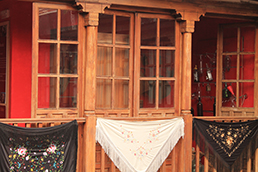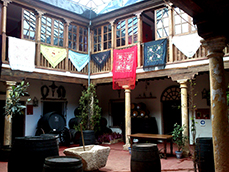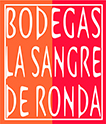The building contains our Wine interpretation Centre and is one of few places that have a millennial tradition of producing wines. In the structure of the building we can appreciate the fusion of the different cultures that have lived in Ronda.
The old Ronda occupied only a small part of the actual old city, nowadays the Plaza Duquesa de Parcent and surroundings, and it was the only place in which are found archaeological remains from the Roman period. In the restoration of the museum we take out many “amphora” “jars”, used for the production of wine and oil.
In the same entrance of our building we can see an octagonal column with geometric figure in the capital that belongs to the “orientalizante” period.
In the same courtyard we can find a Roman frieze, this structure correspond with “ roman village” : we also find several columns around the courtyard in which are spread all the rooms ,from the same roman period and we can also appreciate a “lagar” (a place where grapes were pressed ) of solid stone possibly from “ibero “ culture. During the Arab Period in this block was situated the great King of Ronda´s Palace, and we can find remains from the well Known “Casa del Gigante”, where these rooms were used like a winery, and reusing the warehouseman tools in earlier times.
The floor of the central courtyard is hollow and there was a cistern to collect the grape juice from the press grapes. From this same period is kept the “L” shape in the main entrance just to keep privacy of one`s house. In the Christian period it was used like a winery and it was in this period when the wooden balcony in”Castellano” Style was added
From this period to nowadays this building has been used like a wine cellar and during the 80s stopped to producing wine: the last production of wine was approximately 100. 000liters. The "Sangre de Ronda" winery offers you the opportunity to know, to smell and to savour a tradition in Ronda that has at least 6.000 years of history.
In one of the most beautiful houses in Ronda, which formed part of the "giant's house", They are elements found in this building with most important archaeological value of all the Iberian peninsula,(items Romans and Arabic , and amongst them a wine press). In the XIV century the house was the NAZARI palace and finally towards the middle of the XX century a winery.
The building conserves a lovely courtyard surrounded by columns supporting a wooden balcony.
Since the first prehistoric settlements in our area and the autonomous communities of Andalusia, has been observed in our evolution, we have developed a key product in food, recreation and religious rituals, wine. From the Iberians, Greeks, Carthaginians, Byzantines, Phoenicians, Romans, Visigoths, Arabs. Everyone did what they are today. Their wines left vestiges of what were, at the same time, enriched and improved production, with the varieties and knowledge of new techniques.


Until 1977 it was used as a warehouse, it was common at harvest time the arrival of loads of grapes on the animals in the yard were footsteps to develop musts then aged over 20 jars that were found in the restoration, reaching develop 100,000 liters per year of traditional Ronda wines were distributed throughout the region, and which came entirely from indigenous grapes of the area.


